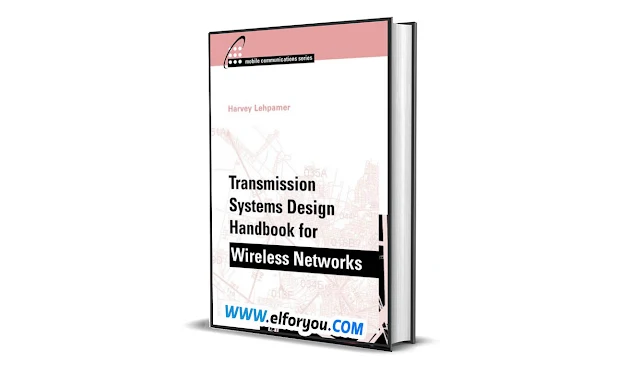Transmission Systems Design Handbook for Wireless Networks PDF.
About:
In the dynamic landscape of wireless communication, the endeavor to launch unrefined local access networks comes with its own set of challenges and costs. "Transmission Systems Design Handbook for Wireless Networks" by William Harvey Lehpamer emerges as an important imagination catering to some specialized and non-specialized professionals, guiding them through the intricacies of deploying evolving technologies. This clause delves into the key insights and offerings of this handbook, shedding dismount on its relevance in addressing contemporary issues and shaping the future of radio set networks.
The book is strategically crafted to turn to the different needs of professionals busy in the establishment of local access networks. Whether you are a veteran expert or a novice in the field, the handbook provides invaluable guidance on navigating the complexities associated with cutting-edge technologies that are still in the transformative stage. As the deployment of varied transmission technologies unfolds, the book meticulously discusses the associated challenges and their profound bearing upon the overall wireless network infrastructure.
A central theme explored in the handbook revolves around the network and the approach to transmission network planning, design, and deployment. By delving into these critical aspects, the writer provides practical guidelines and advice derived from extensive global experience in diverse projects. The target is to fit out readers with the noesis and tools necessary to undertake the increased capacity demands of third-generation wireless networks.
A key highlight of the handbook is its emphasis on a piece of ground information architecture, elucidating how it plays a pivotal role in the formation of the future of transmission network design and deployment. Readers gain an unrefined sympathy for the intricacies of third-generation wireless systems and the heightened capacity requirements that come with them.
The comprehensive reportage spans principles, design considerations, equipment procurement, figure management, and operational aspects of wireless transmittance networks for different applications. Real-life examples of turnkey trading operations within the radio receiver networking industry undefined the content, providing practical insights that bridge the gap between theory and application.
One of the critical themes addressed is the ongoing transfer in global telecommunications, with world telephone operators and emerging independent wireless operators embracing wireless access. This strategical move is driven by the overarching finish of significantly reducing delivery costs, particularly in the local loop—the most expensive section of the network. The handbook serves as a radio beacon for those navigating this transformative phase, offering a wealth of knowledge to inform decisions and actions.
In conclusion, "Transmission Systems Design Handbook for Wireless Networks" stands as an indispensable guide in the realm of wireless communication. By addressing the challenges, costs, and transformative technologies shaping local get-at networks, the handbook empowers professionals to navigate this evolving landscape with confidence. Whether you are mired in project management, network planning, or deployment, this handbook serves as a compass, guiding you through the intricacies of wireless transmission systems design with practical insights and real-world examples
Contents Chapter:
1. Introduction:
- The journey begins with a foundational undefined in the introduction, scene the stage for a comprehensive understanding of wireless networks. It serves as a gateway, providing context and initiating the subscriber into the intricate worldly concern of transmission systems design.
2. Basics of Wireless Networks:
- edifice on the introductory foundation, this section delves into the rudiments of tune networks. It covers fundamental concepts, technologies, and components that constitute the backbone of wireless communication, laying the base for more in-depth exploration.
3. Transmission-Network Principles:
- With a focalize on the core principles governing transmission networks, this segment delves into the theoretical underpinnings. It explores the principles that undefined the efficient and reliable transfer of data crosswise tune networks, providing a theoretical framework for succeeding practical applications.
4. Wireless-Network Architecture:
- Transitioning from principles to practice, this section explores the architecture of wireless networks. It delves into the biological science plan and organization of wireless systems, and offers insights into the components that put up a seamless and operational network.
5. Theory and Principles of Fiber-Optic Transmission:
- A critical aspect of modern transmission, this segment illuminates the theory and principles of fiber-optic transmission. It explores the role of fiber optics in data transfer, unraveling the intricacies of this advanced technology.
6. Microwave Point-to-Point System Design:
- Focusing on particular system design, this segment hones in on microwave point-to-point systems. It covers the design principles and considerations for these systems, sloughing light on their practical application in tune networks.
7. Transmission-Network Planning and Design:
- Expanding the telescope to the holistic provision and design of transmittance networks, this section provides a strategic approach. It encompasses the methodologies and considerations involved in planning a robust and effective transmittance network.
8. Transmission Equipment:
- Delving into the ironware side, this section explores transmission equipment. It covers the diverse range of tools and devices that help information transfer, providing an understanding of the technological armory employed in wireless networks.
9. Transmission-Network Deployment:
- The realistic implementation stage takes center stage in this section, addressing the undefined transmission networks. It navigates the challenges and considerations encumbered in translating theoretical designs into work networks.
10. Transmission-Network Testing and Commissioning:
- The final exam stage of the journey involves testing and commissioning. This section explores the methodologies and procedures employed to ensure the integrity and functionality of transmittance networks, emphasizing the critical role of thorough testing earlier full-scale operation.
In essence, this comp guide unfolds as an organized undefined through the realms of wireless networks. Each segment plays a different role, from laying foundational knowledge to exploring advanced technologies and practical deployment considerations. Whether you are a novice or an expert, this steer serves as a roadmap, providing the insights and noesis needed to navigate the complex landscape painting of tune transmittance systems design.
Information:
Title: Transmission Systems Design Handbook for Wireless Networks.
Language: English.
Size: 1.65 Mb.
Pages: 633.
Format: PDF.
Author: By Harvey Lehpamer.
